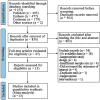Is unicompartmental knee arthroplasty a better choice than total knee arthroplasty for unicompartmental osteoarthritis? A systematic review and meta-analysis of randomized controlled trials
- PMID: 38997246
- PMCID: PMC12233926
- DOI: 10.1097/CM9.0000000000003193
Is unicompartmental knee arthroplasty a better choice than total knee arthroplasty for unicompartmental osteoarthritis? A systematic review and meta-analysis of randomized controlled trials
Abstract
Background: The choice of unicompartmental knee arthroplasty (UKA) vs . total knee arthroplasty (TKA) in the surgical treatment of knee osteoarthritis (KOA) remains controversial. This study aimed to perform a systematic review and meta-analysis of randomized controlled trials (RCTs) to compare the clinical results of UKA and TKA for treating unicompartmental KOA.
Methods: PubMed, Embase, and the Cochrane Library were systematically searched for articles published up to January 2, 2023. The literature was rigorously screened to include only RCTs comparing UKA and TKA for unicompartmental KOA. A systematic review and meta-analysis were performed to calculate the mean difference (MD), relative risk (RR), and 95% confidence interval (CI) according to the Cochrane standards.
Results: Thirteen publications involving 683 UKAs and 683 TKAs were analyzed. Except for one study with a follow-up period of 15 years, all outcome measures reported were within 5 years of follow-up. Meta-analysis showed better knee recovery (MD: 1.23; 95% CI: 1.01-1.45; P <0.001), greater knee function (MD: 1.78; 95% CI: 0.34-3.22; P = 0.020), less pain (MD: 0.75; 95% CI: 0.43-1.06; P <0.001), and better health status (MD: 3.75; 95% CI: 0.81-6.69; P = 0.010) after UKA than TKA. However, considering the minimal clinically important difference values for these variables, the findings were not clinically relevant. Moreover, UKA patients had fewer complications (RR: 0.59; 95% CI: 0.45-0.78; P <0.001) and shorter hospital stays (MD: -0.89; 95% CI: -1.57 to -0.22; P = 0.009) than did TKA patients. There were no statistically significant differences in terms of postoperative range of movement, revision, failure, operation time, and patient satisfaction.
Conclusions: In terms of clinical efficacy, there was no obvious advantage of UKA over TKA in the surgical treatment of knee OA when considering the minimal clinically important difference. The main advantage of UKA over TKA is that it leads to fewer complications and a shorter length of hospital stay. It is ideal to perform prospective studies with longer follow-up periods to fully evaluate the long-term efficacy and safety of the two procedures in the future.
Keywords: Meta-analysis; Systematic review; Total knee arthroplasty; Unicompartmental knee arthroplasty; Unicompartmental knee osteoarthritis.
Copyright © 2024 The Chinese Medical Association, produced by Wolters Kluwer, Inc. under the CC-BY-NC-ND license.
Conflict of interest statement
None.
Figures





Similar articles
-
Comparative outcomes of revision total knee arthroplasty: a systematic review and meta-Analysis of high tibial osteotomy vs. unicompartmental knee arthroplasty.BMC Musculoskelet Disord. 2025 Aug 12;26(1):780. doi: 10.1186/s12891-025-08891-7. BMC Musculoskelet Disord. 2025. PMID: 40796820 Free PMC article.
-
Clinical Outcomes of Revision Total Knee Arthroplasty after High Tibial Osteotomy and Unicompartmental Knee Arthroplasty: A Systematic Review and Meta-Analysis.Orthop Surg. 2022 Aug;14(8):1549-1557. doi: 10.1111/os.13311. Epub 2022 May 25. Orthop Surg. 2022. PMID: 35611758 Free PMC article.
-
Is unicompartmental knee arthroplasty (UKA) superior to total knee arthroplasty (TKA)? A systematic review and meta-analysis of randomized controlled trial.Eur J Orthop Surg Traumatol. 2015 Jul;25(5):799-806. doi: 10.1007/s00590-015-1610-9. Epub 2015 Feb 13. Eur J Orthop Surg Traumatol. 2015. PMID: 25676725
-
Disease progression, aseptic loosening and bearing dislocations are the main revision indications after lateral unicompartmental knee arthroplasty: a systematic review.J ISAKOS. 2022 Oct;7(5):132-141. doi: 10.1016/j.jisako.2022.06.001. Epub 2022 Jun 28. J ISAKOS. 2022. PMID: 35777698
-
Better short-term function after unicompartmental compared to total knee arthroplasty.BMC Musculoskelet Disord. 2021 Apr 2;22(1):326. doi: 10.1186/s12891-021-04185-w. BMC Musculoskelet Disord. 2021. PMID: 33810795 Free PMC article.
Cited by
-
Efficacy and Safety of Adding 1 μg/Kg Dexmedetomidine to 20 ml Bupivacaine in Supraclavicular Brachial Plexus Block: A Randomized Trial.Curr Drug Saf. 2025;20(4):490-497. doi: 10.2174/0115748863332349241108094956. Curr Drug Saf. 2025. PMID: 39835564 Clinical Trial.
-
Comparison of the clinical efficacy of lateral versus medial unicondylar replacement for unicompartmental osteoarthritis of the knee: a meta-analysis.J Orthop Surg Res. 2025 Jan 4;20(1):12. doi: 10.1186/s13018-024-05404-5. J Orthop Surg Res. 2025. PMID: 39754240 Free PMC article.
-
Patients with Robotic Arm-Assisted Medial Unicompartmental Knee Arthroplasty (mUKA) Regain Their Preoperative Activity Level Two Weeks Earlier Compared to Robotic Arm-Assisted Kinematically Aligned Total Knee Arthroplasty (rKA-TKA).Sensors (Basel). 2025 Mar 8;25(6):1668. doi: 10.3390/s25061668. Sensors (Basel). 2025. PMID: 40292742 Free PMC article.
References
-
- Longo UG, Loppini M, Trovato U, Rizzello G, Maffulli N, Denaro V. No difference between unicompartmental versus total knee arthroplasty for the management of medial osteoarthtritis of the knee in the same patient: A systematic review and pooling data analysis. Br Med Bull 2015;114:65–73. doi: 10.1093/bmb/ldv009. - PubMed
-
- Insall J, Aglietti P. A five to seven-year follow-up of unicondylar arthroplasty. J Bone Joint Surg Am 1980;62:1329–1337. doi: 10.2106/00004623-198062080-00013. - PubMed
Publication types
MeSH terms
LinkOut - more resources
Full Text Sources
Medical

